Coin Rarities & Related Topics: News and Analysis regarding scarce coins, coin markets, and the coin collecting community, #205
A Weekly CoinWeek Column by Greg Reynolds
Many collectors were surprised to learn that Eric P. Newman had a tremendous collection of European coins and many excellent coins from elsewhere in the world. After all, the Eric Newman Collection will be best remembered for classic U.S. coins and other numismatic items relating to the history of the United States of America. Newman’s world coins were auctioned by Heritage in New York on Jan. 14th and 15th. This sale realized more than $6 million, which is a large total for a collection of world coins.
Newman’s collection of world coins will be best remembered for items from German-speaking societies, Transylvania, Italian societies, and Scandinavia, though rarities from all coin-producing continents were included. As a substantial number of the leading rarities in this collection are from German speaking societies, a few are discussed in detail herein. A small number of Russian rarities were subject to very intense bidding and these are covered as well. Selected rarities from other societies in Europe are discussed. It is not practical to report upon a large number of the hundreds of European rarities that were in the Newman Collection. In total, more than 1800 world coins from the Newman Collection were sold by Heritage this month.
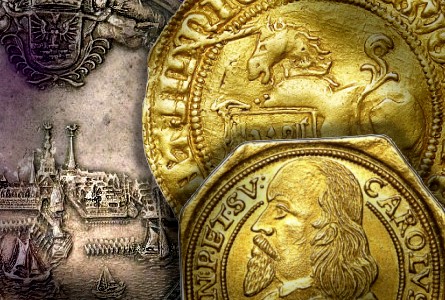 Yes, there were some extremely important coins from Latin America, a few distinctive coins from Canada, a relatively small number of Asian rarities, and some other non-European items. As European coins, including coins from Russia and the British Isles, constituted a majority of Newman’s collection of world coins and the vast majority of newsworthy items in this sale, European coins are the current topic. This sale of Newman’s world coins will not be remembered as featuring a landmark offering of Latin American rarities, though it did not contain more than a few important and attractive Latin American coins.
Yes, there were some extremely important coins from Latin America, a few distinctive coins from Canada, a relatively small number of Asian rarities, and some other non-European items. As European coins, including coins from Russia and the British Isles, constituted a majority of Newman’s collection of world coins and the vast majority of newsworthy items in this sale, European coins are the current topic. This sale of Newman’s world coins will not be remembered as featuring a landmark offering of Latin American rarities, though it did not contain more than a few important and attractive Latin American coins.
Newman’s groups of coins from Transylvania (a region in the present nation of Romania), Sweden and the British Isles were especially noteworthy, in terms of quality, rarity and depth, though it is not practical to explain entire groups of these in a review, even a review as detailed as this one. I report upon a few of these and I mention a couple of Italian pieces as well. I note, however, that there were more than a dozen very important Italian gold coins in the Newman Collection, which tend to be more complicated than most European coins.
For centuries, many of the coins issued in Europe were minted by very small nations, city-states, small semi-independent societies, or imprecisely defined political entities. Transylvania is (or was) a society that amounts to, in terms of geography, a large portion of the present nation of Romania.
An important gold coin (One Ducat) of 1613, which weighs about one-ninth of a Troy ounce, in the Newman Collection featured a portrait of Gabriel Bathori, then leader of Transylvania. It is NGC graded “MS-65,” an especially high certification for a coin from this region dating from the early 1600s! This 1613 gold coin sold for $15,862.50. The next lot was an additional representative of the same rare issue.
This second, Newman Collection 1613 One Ducat, Transylvanian (Romanian) coin is NGC graded “AU-55.” It garnered $4,993.75. Another Newman Collection, One Ducat gold coin of the same year, though of a different design and struck at a different mint in Transylvania, is NGC graded “AU-58,” and sold for $4406.25. Four hundred year old, quality gold coins usually do not cost a vast fortune.
Although most of the Transylvanian and Italian rarities in this collection are gold coins, there were many rare and important silver coins from around the world in the Newman Collection. A 1599 silver dollar (“Daler”) that was struck at the Stockholm Mint is extremely rare and of great historical significance.
In 1599, there were unresolved political conflicts that very much affected the future of Sweden. The fact that neither a monarch nor a religious figure is depicted on this ‘silver dollar’ is noteworthy. Conflicts between protestants and catholics in Sweden were then a major cause of overall political instability. Curiously, there are letters in Hebrew on the reverse (back of the coin). This large silver coin is NGC graded “MS-63.” I am not sure whether the $35,250 result was a strong price or a weak price. While $35,250 would not be a vast sum for a rare U.S. silver dollar, it is a large amount for a Swedish silver coin.
I. Scottish Rarities
No single English coin was a star of the sale. Newman’s collection of British coins, as a whole, was important. I mention here three popular Scottish rarities that were in this sale. The unicorn gold coins of Scotland are among the most famous and curious of all gold pieces.
 The Newman Collection, ‘One Unicorn’ gold coin of King James III is an excellent representative of the ‘Unicorn’ gold denomination and design concept. This specific coin is NGC graded “AU-50.” Collectors of U.S. coins would probably see that it has been notably cleaned and some of the wear on the obverse (front) is due to a not so fortunate cleaning. It has naturally retoned, however, and the pale green tints and other natural colors are attractive. For a circulated, Scottish coin dating somewhere from 1469 to 1488, probably in the 1480s, its quality is impressive. The $28,200 result was slightly strong.
The Newman Collection, ‘One Unicorn’ gold coin of King James III is an excellent representative of the ‘Unicorn’ gold denomination and design concept. This specific coin is NGC graded “AU-50.” Collectors of U.S. coins would probably see that it has been notably cleaned and some of the wear on the obverse (front) is due to a not so fortunate cleaning. It has naturally retoned, however, and the pale green tints and other natural colors are attractive. For a circulated, Scottish coin dating somewhere from 1469 to 1488, probably in the 1480s, its quality is impressive. The $28,200 result was slightly strong.
The next lot was a Half Unicorn gold coin of King James IV, who ruled Scotland from 1488 to 1513. This Half Unicorn gold coin, which features a full figure of a unicorn on the obverse (front), is NGC graded as ‘Extremely-Fine 40.’ Although I spent just a few seconds viewing it, I was impressed. While a circulated coin from around 1500 will have imperfections, this is probably an excellent coin overall. It seemed, at a glance, to be very original, to be characterized by honest wear, and to have few contact marks. The $4993.75 result is much more than a problematic coin of this type would have brought, though still perhaps a good deal.
The Eighty Shillings gold coins that show King James VI (who was later King James I of England) wearing a fur hat were minted from 1591 to 1593 or 1594. The one in the Newman Collection is NGC graded “MS-62.” Like many coins that 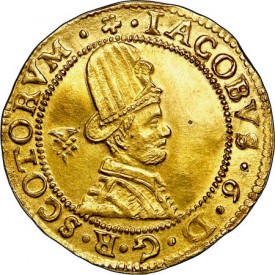 were earlier in the Col. E.H.R. Green Collection, it was dipped, perhaps by those involved with Green’s estate, in a powerful acidic solution. Even so, this coin is sharply struck, strictly uncirculated and has few contact marks. It certainly would grab the attention of most collectors who see it. The price realized of $55,812.50 was strong, though very much understandable.
were earlier in the Col. E.H.R. Green Collection, it was dipped, perhaps by those involved with Green’s estate, in a powerful acidic solution. Even so, this coin is sharply struck, strictly uncirculated and has few contact marks. It certainly would grab the attention of most collectors who see it. The price realized of $55,812.50 was strong, though very much understandable.
In Sept. 2010, St. James Auctions, which is operated by Stephen Fenton, sold a 1593 dated coin of this same type. “About Extremely Fine” and “the first example [of this type] to appear at auction in some four years,” said the cataloguer for St. James Auctions. It sold for £14,000 (about US$22,000 at the time.)
II. Italian Highlights
An explanation and analysis of the important Italian pieces in this sale would require a book. I mention just a couple of newsworthy results. The Newman Collection “Francesco Morosini Osella” of Venice, with a denomination of Three Zecchini (= Three Ducats), is exceptional for a coin of this type. It is NGC graded “AU-58” and was well struck. The $38,187.50 result is very strong. These coins were minted in the late 1600s and are somewhat esoteric.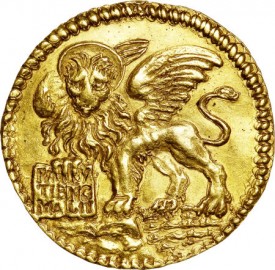
There were many other rare and distinctive gold coins of Venice in the Newman Collection. Indeed, this sale featured a landmark offering of these. I am not ideally suited to analyze them.
In my view, the coins of Venice from the 1600s and 1700s are much more attractive and interesting than the coins of the Kingdom of Italy from the 1800s and 1900s. A star of this sale, though, is a King Vittorio Emmanuele III 1902-R Twenty Lira gold coin. This piece is extremely rare and the fact that it is NGC graded “MS-66”contributes to its value. Coins of this type were minted in 1902, 1903, 1905 and 1908. There is also a rarer variety of 1902 dated coins of this design type.
Those dated 1903 and 1905 are probably much less rare. Heritage just auctioned an NGC graded “MS-63” 1905 Twenty Lira coin of this type, on Jan. 6th, for $1880. In 2012, the firm of “Maison Polombo” auctioned an NGC graded “MS-61” 1903 for the equivalent of about US$5600 and an NGC graded “MS-63” 1905 in 2011 for 2000 Swiss Francs ($2150).
In Oct. 2013, Spink auctioned a 1902 of this type that was not certified. It brought £23,000 (then about $37,000). That price and the price realized of of $52,875 for this 1902 both seem strong to me. I am not, however, an expert in 20th century Italian coins.
III. Who was bidding?
According to a document publicly released by the auction firm, there were 499 successful bidders: 222 bid via the Internet in advance of the event, 209 bid on the ‘Heritage Live’ Internet system while auction sessions were in progress, and seventeen successfully bid “by mail,” a number which probably includes bids sent by ‘fax’ as well. Although Heritage reveals fifty-one “floor” bidders were successful, I am almost certain that this number of “floor” bidders includes participants at other locations who were bidding by telephone through Heritage employees.
During the evening of Tues., Jan. 14th, I counted around twenty-five dealers and collectors in attendance, at least ten of whom were leading bidders in this auction. Indeed, to the best of my recollection, other than Heritage employees and security guards, more than two-thirds of the people present bid competitively in the auction. For the most part, the people there were very serious about buying coins. The ‘floor’ bidding was lively.
Indeed, the first session was much more exciting than I thought it would be. For many lots, there were battles among floor bidders. Lots were selling at a rate of about sixty per hour. Lots have sold at a rate of more than 160 per hour during some other Heritage coin auctions that I have attended.
Among those bidding ‘in person,’ there were at least two dealers from Austria, seemingly two from Italy, and three or more from Germany. Curiously, several European dealers in attendance do not wish for their respective names to be mentioned. So, I will not mention them. Among those who live in the United States, Andy Lustig and James Ricks, separately, were very competitive bidders.
A New York wholesaler of U.S. coins also seriously participated. He and Lustig were the only two veteran dealers in U.S. coins in attendance. A high level representative of a large German firm, the leader of a coin company located in Switzerland, and an Italian dealer, were the major forces among bidders present. A relatively young dealer, who I am told is German, was also a major factor in bidding contests for many coins.
IV. Who is Eric Newman?
Much background information regarding Newman and his collection may be found in part 1 of this series. (Clickable links are in blue.) He is one of the most famous of all collectors of American numismatic items. (Numismatics relates to the study of and collecting of coins, medals, paper money, and particular kinds of tokens.) Furthermore, Newman has written a great deal of material relating to American numismatics. He is now 102 years old. Some of the proceeds of the sales of his collection will be used to support the Newman Money Museum at Washington University in St. Louis, Missouri.
It has been common knowledge that Newman and a St. Louis dealer acquired a large number of numismatic items from the estate of E. H. R. Green, a legendary collector who formed one of the all-time greatest collections of U.S. coins. While it was known that Green collected world coins as well, very few people knew, before this sale was announced, that Newman collected world coins.
A leading European dealer at the auction was amazed by several of the Newman Collection coins from German speaking societies. He had no idea that some of them even existed. In particular, he was overwhelmed by the Emden 1674 Two Taler ‘City-View’ silver coin, which can fairly be thought of as a silver double dollar.
V. Beautiful Double Dollar!
A ‘One Taler’ silver coin is very similar to a United States Silver Dollar. Talers, Thalers, Dalers, Daalders, Spanish Eight Reales coins, and many other large silver coins, are ‘Crowns,’ standard issues of silver coinage that usually each weighed around 28 grams, almost always between 25 grams and 31 grams, thus between four-fifths (0.8) and one Troy ounce. Silver coins are not usually 100% or even 99% silver. They often consist of from 5% to 25% copper. At the moment, I do not remember the precise alloys of Talers from German speaking societies. Most certainly, they are at least 80% silver, perhaps five-sixths (83.33%) silver?
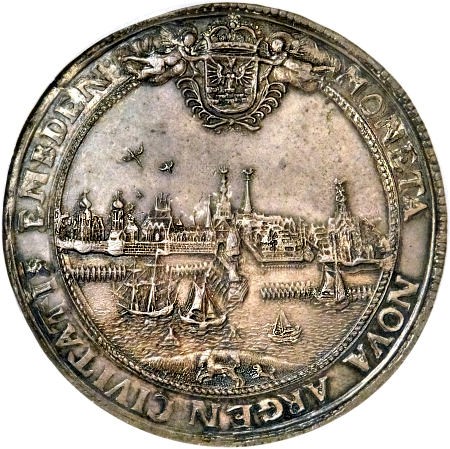 A Two Taler silver coin is especially distinctive. It weighs about as much as two U.S. Silver Dollars. The Two Taler coins of Emden are listed in the pertinent Krause-Mishler Standard Catalogue as weighing 57.98 grams (1.86 Troy ounces) and as having a diameter of 57 mm (2.24 inches). It would have made sense for the Heritage cataloguers or Newman’s representatives to have had the coins weighed and measured before sending them to the NGC.
A Two Taler silver coin is especially distinctive. It weighs about as much as two U.S. Silver Dollars. The Two Taler coins of Emden are listed in the pertinent Krause-Mishler Standard Catalogue as weighing 57.98 grams (1.86 Troy ounces) and as having a diameter of 57 mm (2.24 inches). It would have made sense for the Heritage cataloguers or Newman’s representatives to have had the coins weighed and measured before sending them to the NGC.
‘One Taler ‘coins and lower denominations were also issued by the city of Emden, though these other silver denominations do not feature the view of the city that appears on the Two Taler coins. Emden is a seaport in the northwest of the region that now constitutes the nation of Germany. Emden was an independent city-state from 1595 to 1744, when it became part of Prussia. In earlier and in later eras, Emden was part of various political entities, which are too complicated to explain here.
The Emden ‘Two Taler’ coins were minted only in 1674. Other city-states in the region issued so called ‘city-view’ coins that feature an artistic rendition of a view of the respective city and/or its harbor from a distance. All ‘city-view’ Talers are rare.
Although the Newman Collection, Emden Two Taler ‘city-view’ coin is of tremendous rarity, it is the quality of this coin that is incredible. Though a leading coin dealer in Europe for decades, one bidder in attendance had never before seen such a ‘city-view’ silver coin from any German speaking society or nearby society that approaches the quality of this coin. He said that this piece is “very beautiful” and is almost unbelievable.
I admit that I, too, was astonished by the quality of the coin. It has wonderful blue-tinted, medium brown-russet, natural toning. Despite various kinds of mint-caused imperfections, it is a fabulous coin. Collectors tend to expect to see mint-caused imperfections when viewing silver coins from the 1600s.
Under five-times magnification, this coin has almost zero scratches and contact marks. This fact alone is amazing, as it is a very large coin that was minted in 1674.
This coin scores extremely high in the category of originality. The toning is definitely natural. Moreover, there is no evidence of dipping or any kind of cleaning. This coin as a whole is more than very attractive. I place its grade in the high end of the 66 range.
Bidding started at a little less than $45,000. For a while, ‘Heritage Live’ participants seemed to be battling each other, for this ‘double dollar.’ The already mentioned, young German dealer then indicated $64,625 ($55k + 17.5%), and he was later to be the underbidder at $105,750.
The successful bidder, at $111,625, is a principal of a coin firm in Switzerland, or at least he was when I met him at the Eliasberg sale of world coins in April 2005. It was clear that he was a principal of or at least connected to that Swiss firm at this auction. There was speculation that this successful bidder intends to place this Emden 1674 Double Taler in his own personal collection, which is rumored to be phenomenal.
Most of the prices realized during the night of Tuesday, Jan. 14, were strong, though I doubt that this result is one of them. Given the quality, rarity and awestriking characteristics of this specific coin, and the popularity of ‘city-view’ Talers (dollars) in general, I was expecting a higher price. This was one of the best buys in the sale. It is a coin that I will clearly remember for the rest of my life.
VI. Possibly Unique 1612 Fourteen Ducats
A very strong price was $211,500 for a Salzburg 1612 Fourteen Ducats gold piece, which depicts the bishop who was then the leader of the city. Salzburg was then an independent city-state of sorts and is now a major city in Austria. This piece is large and thick; it weighs 48.416 grams according to its NGC holder. Researchers have been unable to find a record of another one of the same design type and Fourteen Ducats denomination.
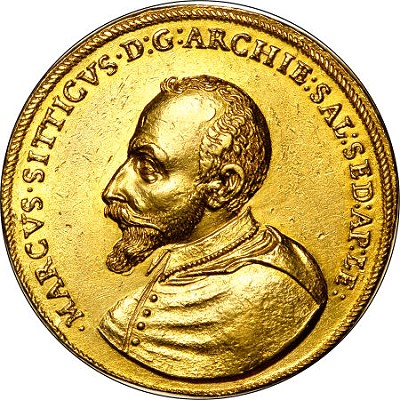 Ducats are classic international monetary units. I have heard European dealers pronounce ‘ducat’ in English as ‘duck-ette’ or as ‘duck-itt.’ Is there a more accurate way of pronouncing this term? Also, the Italian concept of a ‘zecchino’ is equal to a ducat and ‘zecchini’ refer to multiple monetary units that are equal to ducats.
Ducats are classic international monetary units. I have heard European dealers pronounce ‘ducat’ in English as ‘duck-ette’ or as ‘duck-itt.’ Is there a more accurate way of pronouncing this term? Also, the Italian concept of a ‘zecchino’ is equal to a ducat and ‘zecchini’ refer to multiple monetary units that are equal to ducats.
A ‘One Ducat’ gold coin weighs 3.5 grams, around an eighth of a standard ‘avoirdupois’ ounce, and a little more than one-ninth of a Troy ounce. For six to seven centuries, starting in the late 1200s, ducats, and gold coins with other names minted in accordance with the Ducat standard, circulated widely and frequently in central and Western Europe, and certainly circulated elsewhere, including in Russia.
There were various large denominations in ducats of gold coins struck in Salzburg in the 1500s and 1600s: ten, twelve, sixteen, twenty, twenty-four and twenty-five, and fifty. Fourteen Ducats, however, was one of the most unusual denominations. The nature of this piece is a mystery.
For a large gold piece from the 1600s, the quality of this piece is excellent. The NGC grade of “58” could not be seriously challenged by a grading expert. Indeed, in the U.S., if well paid to analyze it, many grading experts would assign a 62 grade to this piece.
Most large gold pieces from past centuries have been heavily cleaned, sometimes in a destructive manner. This piece was only lightly cleaned and has some minor hairlines. It could have been very lightly dipped once or twice.
To naked eyes, hardly any contact marks are visible. Under five-times magnification, a whole bunch of very small marks can be seen. For a coin that weighs around 50% more than a U.S. Double Eagle ($20 gold coin), these marks are not particularly significant.
Yes, there is some very light friction, especially in the hair of the Archbishop. If not for such friction, this would be a choice uncirculated item. This piece has some pleasing greenish tints, which are often seen on old gold pieces. It is more than attractive overall.
Bidding started at more than $50,000. An Austrian dealer soon indicated $70,500. There was a “book” bid of $76,375 ($65k + 17.5%). There were a few participants as the bidding level was pushed higher. That same Austrian dealer bid $129,250 and, seconds later, $152,750. Someone in the back row, I believe, possibly an Italian dealer, pushed the level to $164,500 or more.
A few seconds later, a European dealer in the front of the auction area, who was wearing a blue blazer, signaled $205,625 ($175k+17.5%). A telephone bidder, through a Heritage employee, was successful with a bid of $211,500 (=$180k+17.5%).
An Austrian coin or medal selling for $211,500 is sort of equivalent to a U.S. coin selling for a million dollars. One rumor, from a reliable source, suggests that it may have been purchased by a bank in Austria that is building a collection of numismatic items.
VII. Unusual 1672 Ten Ducats
The Newman Collection 1672 Ten Ducats gold piece of Saxe-Altenburg is even more mysterious and may be unique as well, though there could be others in ‘old-time’ collections. According to the Heritage cataloguer, it was struck with dies that were used for (or intended for) the minting of Double Taler silver coins.
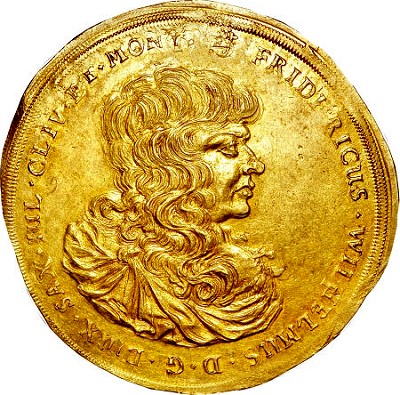 Duke Friedrich Wilhelm III of Saxe-Altenburg, an independent society, never reached adulthood. Indeed, he died in 1672 and the Duchy of Saxe-Altenburg came to an end. This piece has the appearance, at a glance, of some kind of commemorative or medal, rather than a coin. Although a weight is not mentioned in the catalogue or on the NGC holder, it probably makes sense to assume that it weighs thirty-five grams, or thereabouts, since it is described as a Ten Ducats coin.
Duke Friedrich Wilhelm III of Saxe-Altenburg, an independent society, never reached adulthood. Indeed, he died in 1672 and the Duchy of Saxe-Altenburg came to an end. This piece has the appearance, at a glance, of some kind of commemorative or medal, rather than a coin. Although a weight is not mentioned in the catalogue or on the NGC holder, it probably makes sense to assume that it weighs thirty-five grams, or thereabouts, since it is described as a Ten Ducats coin.
The overall mellow gold color is really nice. The russet-copper tints about the outer design elements and outer fields are attractive.
It was moderately cleaned in a manner that left some hairlines, which are not particularly distracting. There is a lot of scuff, probably natural, covering hairlines and very few medium scratches. For such a large gold coin, the hairlines and scratches are not serious issues. Plus, pale green tints in the inner fields are typical of old gold pieces and are generally appealing.
There are a variety of and a number of mint-caused imperfections. Given the fact that people at that mint were not planning to and/or did not have experience in producing Ten Ducat coins or Double Taler silver coins, it is not surprising that they had trouble producing this piece.
In terms of striking characteristics and grade, it is really a better item than readers of the catalogue might imagine it to be. The portrait of the young duke is in relatively high relief. This coin has much original luster. It is mostly original overall. When exactly was it made and why? As the young duke died that year, could this piece have been made to memorialize him or the entire duchy. There were no other heirs.
The NGC grade of AU-58 is appropriate. Given the esoteric and obscure nature of this item, and the fact that so few German items are even worth more than $50,000 each, I found the $105,750 result to be strong. I would not have been surprised if it had brought less than $75,000.
Several Ten Ducats or Twelve Ducats coins from the late 1500s and early 1600s, of around the same quality as this Saxe-Altenburg piece, have been auctioned for amounts ranging from more than US$20,000 to less than $90,000.
The Bishop von Raitenau multiple ducat coins of Salzburg are older, more attractive, more historically significant, and most likely true coins. These are more familiar to collectors than this Saxe-Altenburg 1672 piece or the already mentioned Salzburg 1612 Fourteen Ducats piece. As far as I know, none of the von Raitenau-Salzburg Ducats have ever sold at auction for more than US$100,000 or an equivalent in another currency, though the larger denominations are rarely offered.
In 2012, the Swiss firm of Hess-Divo auctioned a von Raitenau-Salzburg Four Ducats coin for 18,000 Swiss Francs, then equivalent to more than $23,000. As I reported, in Jan. 2013, Heritage auctioned, a little more than a year ago, a Bishop von Raitenau of Salzburg 1594 Eight Ducats coin for $73,437.50. Though not quite as rare as the Fourteen Ducats 1612 Salzburg piece and Saxe-Altenburg Ten Ducats pieces in the Newman Collection, which may each possibly be unique, that Eight Ducats coin is a Great Rarity and is conservatively NGC graded “MS-63.” It is of notably higher quality and of a more recognized design than either of these Newman Collection pieces.
At the auction, the bidding contest for this Saxe-Altenburg piece seemed to be a contest between bidders on ‘Heritage Live’ and an Italian dealer in the room. Eventually, the Italian dealer captured this piece for the already mentioned price of $105,750.
VIII. Eight Sided 1653 Three Ducats
One of the most exciting of all the Newman Collection rarities from German-speaking societies is a 1653 Three Ducat piece from Breslau. It is not round; it has eight sides. Many coins from German-speaking societies are not round.
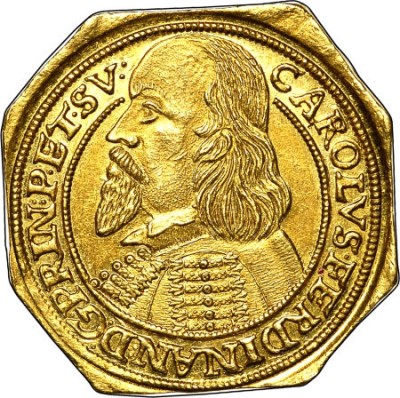 The Three Ducats denomination is a little unusual. These were made in several societies in Western Europe during the 1600s, 1700s and 1800s. They were probably minted in quantities that were smaller than more standard ducat denominations and few survive.
The Three Ducats denomination is a little unusual. These were made in several societies in Western Europe during the 1600s, 1700s and 1800s. They were probably minted in quantities that were smaller than more standard ducat denominations and few survive.
Breslau is now known as Wroclaw, a city in Poland. Karl Ferdinand Vasa was the monarch, if this term is employed loosely, of Breslau/Wroclaw from 1625 to 1655 and he held other political posts in the region. Under his reign, there may have been four Three Ducat coin issues in Breslau during the 1600s, two dated 1832 and two dated 1853, round and octagonal. There were also minted Breslau 1674 Three Ducat coins, under a different ruler, though, in total, these are even rarer than the Three Ducat cons of Karl Ferdinand Vasa.
The round Three Ducat coins of 1632 and 1653 can be found in circulated grades, though they are very rare. Other than the presently discussed coin, I am not aware of any listing of the ‘octagonal’ 1853 issue and I have never even seen a picture of an ‘octagonal’ Breslau 1632 Three Ducat coin, though I have not extensively researched these pieces. There could well be several, of which I am not aware. Since I am not fluent in German or Polish, my access to source materials regarding these is limited.
I am nearly certain that the Newman-Green Breslau 1653 Three Ducats coin is of amazing quality for a Three Ducats coin from the 1600s, of any variety. Of course, it is not perfect. It was moderately, though very apparently dipped, probably in the same kind of acidic solution that was used to dip most of Col. E.H.R. Green’s, pre-1840, silver U.S. coins. Earlier, it may have been subject to a moderate liquid cleaning in a previous century. Furthermore, there is a scratch on the face of the portrait. Even so, there are almost zero other scratches and contact marks. Moreover, the striking quality is incredible. The strike is extremely well detailed and this coin was struck on an excellent flan (blank piece of metal). There are almost zero mint-caused imperfections.
The orange-gold color, in combination with the superb detail, and excellent flan, give the coin a really neat overall appearance. Plus, it is certainly uncirculated. The NGC grade of MS-63 is accurate, in my view.
The price realized of $58,750 was very strong. There are very few coins from German-speaking societies that are worth more than US$50,000 and not many from Poland. There are not a large number of collectors who would seek to complete a set of all Three Ducat issues from Breslau.
Considering that many other German and Polish coins are more popular than this one, I was a little startled by the price realized. One leading dealer, however, described this piece as “unique”! After being a coin dealer in central Europe for decades, he had never seen or heard of another Breslau 1653 Octagonal Three Ducats coin.
Another Breslau gold coin in the Newman Collection grabbed may attention. A 1796 One Ducat coin is incredibly prooflike. It is NGC certified ‘MS-65 Prooflike,’ and I doubt that this certification is controversial. The reflective surfaces on this coin are dynamic. When tilted at certain angles under a light, this coin is spellbinding. Additionally, it is a gem-quality coin. While it is not a Proof, it is an amazingly cool coin, from 1796!
This ‘MS-65 Prooflike’ One Ducat sold for $10,575. As for the rarity of the issue, I know little. I doubt, though, that there are many gem, prooflike Breslau coins from the 1700s.
If a 1796 Quarter Eagle (U.S. $2½ gold coin) had similar characteristics, it would be worth more than $1 million. Indeed, a fairly NGC graded MS-65, 1796 ‘With Stars’ Quarter Eagle sold in a Jan. 2008 Heritage Auction in Orlando for more than $1 million.
IX. Russia: Peter II Ducat
From 2003 to early 2008, growth in demand for rare Russian and Chinese coins outpaced demand for coins from all other countries. The demand for Russian coins continues to be intense. It was hard to tell whether the Russian coins in the Newman Collection brought particularly strong prices or whether the high results were just expected outcomes stemming from the usual mania for Russian numismatic items.
Peter II was Emperor of Russia from 1727 to 1730, not a long reign. There are not a great many Peter II coins available for collectors to add to their respective type sets.
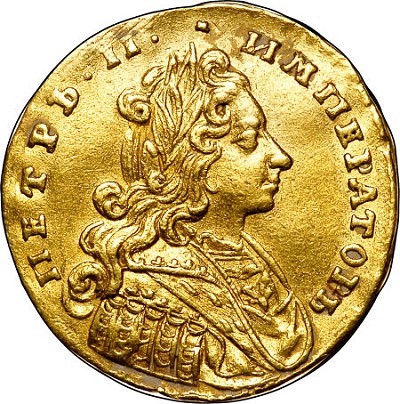 Peter II One Ducat gold coins were minted during just one year, 1729. Although there are two major varieties, these are similar in rarity and very few collectors would seek representatives of both varieties. So, they are worth about the same. While circulated pieces, often with problems, can be found, the Newman Collection, Russian 1729 One Ducat gold coin is of particularly high quality for the issue.
Peter II One Ducat gold coins were minted during just one year, 1729. Although there are two major varieties, these are similar in rarity and very few collectors would seek representatives of both varieties. So, they are worth about the same. While circulated pieces, often with problems, can be found, the Newman Collection, Russian 1729 One Ducat gold coin is of particularly high quality for the issue.
Despite a probable Green Estate dipping and some technical issues, it is an aesthetically appealing coin. It has minimal wear, is sharply struck and has attractive color. The NGC assigned grade of AU-50 is probably a “net” or compromise grade. It has the sharpness of a higher grade and there are negative factors relating to the rims and edge. It is difficult to balance important positive factors and negative ones while figuring a numerical grade. I am not surprised that many Russian collectors demanded this coin for their respective sets. A battle of phone bidders occurred. The result was a mind-boggling price of $205,625! I am not sure how to interpret this amount, which cannot be weak.
In Oct. 2011, the auction firm of Sincona sold another 1729 One Ducat for 55,000 Swiss Francs (~$62k). That one is probably inferior to the Newman-Green coin. In Jan. 2011, in New York, a coalition of auction firms (I believe) sold a PCGS graded “MS-62” 1729 One Ducat for $200,000, though that piece is of higher quality than the presently discussed Newman-Green coin. Also, that PCGS graded MS-62 coin was struck from a notably different obverse die, ‘with ribbon.’
Another of this ‘with ribbon’ variety was auctioned by “Gorny & Mosch ” in Oct. 2010 for a reported price of 100,000 Euros (~$139,500). I have not confirmed the cited prices realized of any auction firm in Europe. In Jan. 201, the firm of Kunker sold still another for 77,000 Euros (~$108,262). It only makes sense, to a limited extent, to compare prices without comparing the exact quality of the coins.
X. Russia: Elizabeth Ducat
Elizabeth was Empress of Russia from 1741 to her death in 1762. Multiple design types of One Ducat gold coins were issued during her reign. The NGC graded ‘Extremely Fine-40’ One Ducat in this Newman Collection is of the first type and is not especially rare. This design type was minted from 1742 to 1748 and more than 50,000 coins in total were produced, though some people collect them ‘by date.’ The Newman Collection had a 1748, which is not a rare date.
 Though NGC graded Extremely Fine-40, the surface quality of this coin is not great. It has naturally retoned after a harmful liquid cleaning. To be honest, I am not sure how it compares to the other survivors of its date or design type. One Ducat coins often found themselves in various European countries, including societies where people collected coins. There are some better representatives of this design type around. The $39,656.25 result was clearly strong. This is not a really special coin.
Though NGC graded Extremely Fine-40, the surface quality of this coin is not great. It has naturally retoned after a harmful liquid cleaning. To be honest, I am not sure how it compares to the other survivors of its date or design type. One Ducat coins often found themselves in various European countries, including societies where people collected coins. There are some better representatives of this design type around. The $39,656.25 result was clearly strong. This is not a really special coin.
In Oct. 2013, the firm of Kunker sold an Elizabeth 1748 One Ducat that very well could be better than this one for 12,000 Euros (~$16,248 ). Curiously, the firm of Sincona reports having auctioned a 1747 for 180,000 Swiss Francs, then nearly $195,000! It is likely to be superior to the Newman coin, though pictures of that one suggest that it is probably not uncirculated. In Feb. 2012, Kunker auctioned a 1748 that has much more detail, and could possibly be uncirculated, for a reported price of 40,000 EUR (~$52,552). In Jan. 2009, an NGC-graded “MS-62” 1748 brought $30,000 in New York.
As for the Catherine II Ten Roubles gold coin of 1766 in the Newman Collection, I will not comment on it. It is NGC graded “AU-53” and it realized $18,800, certainly a strong price.
I was delighted to have the opportunity to carefully examine the Three Roubles 1826 platinum coin. Over the last dozen years, many forgeries of Russian, 19th-century platinum coins have been produced. Experts at grading services have been fooled. I felt I could learn from examining a real one, which probably has been in the Newman Collection for decades.
The rims and dentils are much sharper and more fully formed on this genuine coin than they are on forgeries that I have seen in the past. The semi-prooflike surfaces are entertaining and interesting. The $16,450 result was somewhat strong and unsurprising.
The $18,800 price for the 1875 Three Roubles gold coin is much stronger, and not a good deal. There are many choice coins of this design type. In Sept. 2009, Heritage auctioned a PCGS graded “MS-64” 1869 Three Roubles or $2900.
I very much like this Newman 1875 Three Roubles. I am just not convinced that it merits a 65 grade. It has nice mellow luster with natural toning and natural cloudiness. It is a tan-gold color and there are few contact marks. It has been lightly to moderately cleaned and it might not have the overall attractiveness that most experts expect of a 65 grade coin. Its grade is around the border between 64 and 65; I place it in the 64 range. Of this design type, a collector who searches carefully, with help, could probably find more than one coin that truly grades 65, maybe even one that merits a 66 grade! Perhaps the $18,800 result is worthwhile to someone who collects these ‘by date.’
There is much more that should be written about the Newman Collection of world coins, which will be reflected upon for decades to come. I hope that my discussion here illuminates, to a great extent, the highlights, the scope, the depth, and the most newsworthy aspects of Newman’s collection of European coins. I will probably write, at some points, about English and Latin American coins that were in the Newman Collection.
©2014 Greg Reynolds




